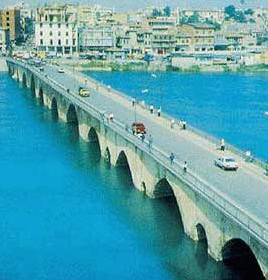Situated in the middle of the Cukurova Plain (Cilician Plain), Adana is the fourth largest city of Turkey, nestled in the most fertile agricultural area of the whole country which is fed by the lifegiving waters of River Seyhan. The city's name originates in mythology, where it was said to have been founded by Adanus, the son of Kronus (God of Weather). Due to its being in the heart of that fertile center Adana has been an important city for many civilizations for centuries dating back to the Hittites and Hittitian Empire. The precious River Seyhan is spanned by the ancient Taskopru (Stone Bridge) which was built by Hadrian and then repaired by Justinian. It is worth noting that to built a 300 yards long stone bridge in Roman times was a real feat.
In the city, the 16th century Great Mosque (Ulu Camii), the Yag or Eski Mosque, the Hasan Aga Mosque, Saat Kulesi (the clock-tower) built in 1882, an old Covered Bazaar, Bedesten or Arasta are of interest. Also be sure to see the Ethnographical Museum where Turkish carpets, swords, manuscript books and tombstones are exhibited. The building itself is interesting as well since it was built as a church by the Crusaders. The Adana Archaeological Museum merits visiting too. Adana is also famous for its delicious Adana Kebap. The tea houses and restaurants alongside the Seyhan Dam and Lake provide a cool and perfect view of the city and the river at sunsets.
There are some ancient cities on the road to Iskenderun which include Roman remnants. Misis Antique Museum is on the caravan route that came from China, India and Persia. Among the remains of Roman times, the most interesting is the elegant mosaic of the 4th century A.D representing Noah's Ark. Yilanlikale has the ruins of a fortress set atop a peak dominating the River Ceyhan. Dilekkaya, the ancient Anavarza, was an important Roman Byzantine city which still preserves the outline of the old city including two particularly worthwhile mosaics. Karatepe National Park is the Neo Hittite site where you will find the remains of the summer residence of King Asitawada, tablets of Hittite and Phoenician inscriptions, and an openair museum holding many remnants. South of Yilanlikale, in the Sirkeli region, at somewhat weathered Hittite relief marks King Muvattalish’s stop here on his way to Egypt. Castabala and Toprakkale are the other historical remains. Burucek, Tekir, Horzum, Zorkum meadows are ideal for picnicing and resting.
The Cukurova University
Balcali campus which is on the eastern side of Seyhan Dam Lake occupies an
area of 20 km2. The name "Balcali" originates from the name of
the village that stood on the present campus before the university was
built. The campus houses administrative and educational buildings with labs
available for research services in various branches of science, a hospital
complex, a central library, a central cafeteria, sports facilities, teacher
residences, social facilities and dormitories which accommodate a total of
3500 students. A large number of public transport vehicles regularly commute
between the city center and the campus, providing mass transport for the
students and university personnel.
|




